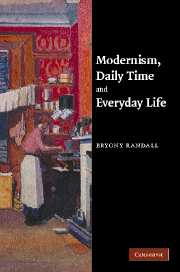Book contents
- Frontmatter
- Contents
- Acknowledgements
- List of abbreviations
- Introduction: dailiness
- Chapter 1 The contemporary context: Henri Bergson and William James
- Chapter 2 Dailiness in Dorothy Richardson's Pilgrimage
- Chapter 3 Re-creation, work and the everyday in Gertrude Stein
- Chapter 4 War-days: H.D., time and the First World War
- Chapter 5 Reading, writing and thinking: a Woolfian daily life
- Afterword
- Notes
- Bibliography
- Index
Introduction: dailiness
Published online by Cambridge University Press: 22 September 2009
- Frontmatter
- Contents
- Acknowledgements
- List of abbreviations
- Introduction: dailiness
- Chapter 1 The contemporary context: Henri Bergson and William James
- Chapter 2 Dailiness in Dorothy Richardson's Pilgrimage
- Chapter 3 Re-creation, work and the everyday in Gertrude Stein
- Chapter 4 War-days: H.D., time and the First World War
- Chapter 5 Reading, writing and thinking: a Woolfian daily life
- Afterword
- Notes
- Bibliography
- Index
Summary
I can say it enough but can I say it more than enough that the daily life is a daily life if at any moment of the daily life that daily life is all there is of life.
The day is a unique temporal category in being, most of the time and in most parts of the world, clearly bounded at beginning and end – by night – and always recurring in a regular rhythm. Close to the poles days can become exceptionally long or exceptionally short, but they will still wax and wane in a predictable annual pattern. Thus, unlike the relatively artificial divisions of the hour or the week, the day presents a naturally occurring, observable temporal unit, one that technology and human innovation cannot change; as Heidegger would concede, it is ‘the “most natural” measure of time’. Even now, at the beginning of the twenty-first century, the fact of there being a pattern of darkness and light that gives rise to something called ‘a day’ cannot ultimately be questioned, undermined, deconstructed we might say; along with death, it is the only thing in life of which we can be sure.
A century ago, during the period when the artistic movement we call modernism was gathering pace, technology was becoming increasingly able to modify and regulate the rhythms of life.
- Type
- Chapter
- Information
- Modernism, Daily Time and Everyday Life , pp. 1 - 28Publisher: Cambridge University PressPrint publication year: 2007



